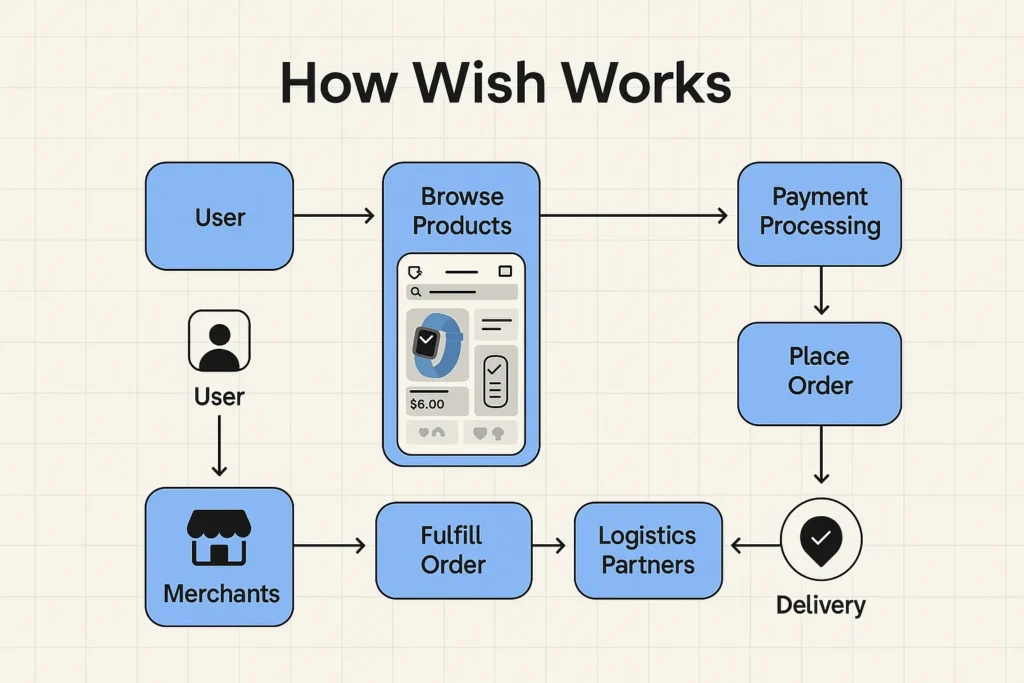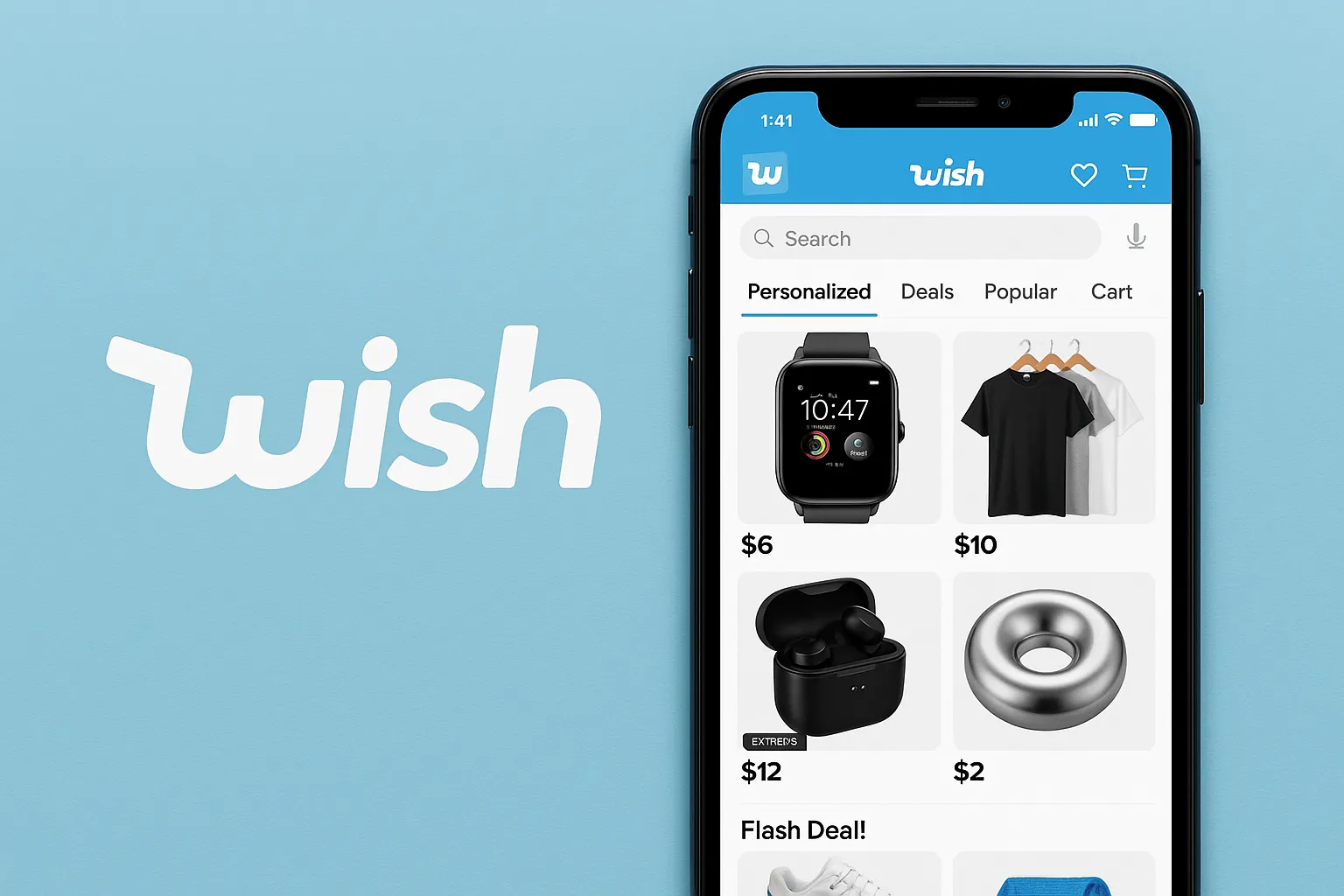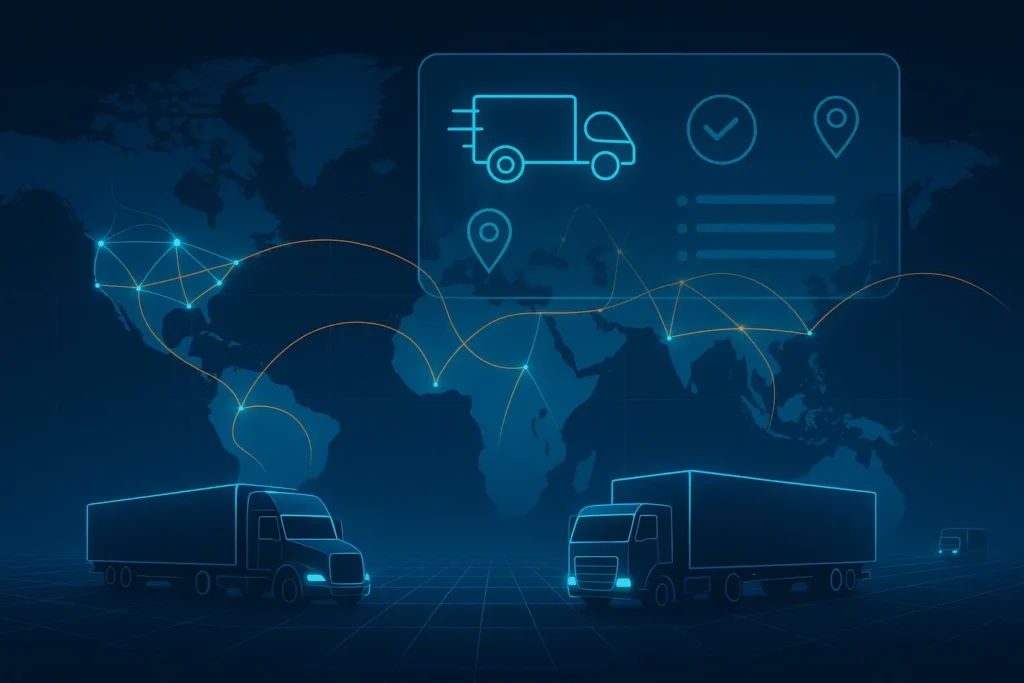Imagine wanting a smartwatch, sneakers, or home gadget at 70–90% cheaper than retail—and getting it delivered right to your door. That’s the everyday experience Wish created for millions of shoppers worldwide.
Wish, launched in 2010 by former Google and Yahoo engineers, became famous for its ultra-budget online shopping model, connecting consumers directly to manufacturers—mostly in China. This direct link eliminated middlemen, making prices unbelievably low and attracting massive global attention.
Fast forward to 2025, Wish has evolved into a smarter, more reliable, AI-assisted shopping platform with better delivery times, curated product listings, and improved quality control, while still holding strong as one of the world’s most downloaded discount-shopping apps.
What is Wish? The Simple Explanation
Wish is a budget-friendly e-commerce marketplace that connects shoppers directly with overseas manufacturers—mainly from China—offering products at extremely low prices. Instead of storing inventory, Wish acts as a middle-layer marketplace, helping users find deals on fashion, electronics, accessories, home goods, beauty items, and more.
The Core Problem Wish Solves
People want affordable products without paying retail markups. Wish solves this by cutting out distributors, wholesalers, and retail overhead.
Target Users & Use Cases
Wish is used by:
- Bargain hunters looking for the cheapest price online
- Trend-followers buying fast-fashion items
- Gift shoppers seeking novelty products
- Budget-conscious customers in the U.S., Europe & Latin America
- Users willing to trade delivery speed for ultra-low prices
Common use cases include buying electronics accessories, apparel, jewelry, home gadgets, crafts, and trending social media finds.
Current Market Position (2025 Stats)
- 70+ million active users globally
- 500,000+ merchants selling on the platform
- Ranked among the Top 20 Shopping Apps in the U.S. (2025)
- New AI-driven product recommendations improved conversions by 22% YoY
- Average order value increased to $14.50 as users shift to higher-quality listings
Why Wish Became Successful
- Ultra-low pricing through direct manufacturer access
- Gamified shopping experience
- Personalized product discovery feed
- Viral marketing & social media-driven trends
- A marketplace model that scaled quickly without inventory costs
Read more: Complete Guide to Starting an E-commerce App Business
How Does Wish Work? Step-by-Step Breakdown
Wish works like a discovery-based marketplace powered by AI. Instead of searching for specific items, users scroll through a personalized feed filled with ultra-cheap products. Here’s the complete breakdown:
For Users (Shoppers)
1. Account Creation Process
- Sign up using email, Google, Facebook, or Apple ID
- Choose preferences (fashion, gadgets, beauty, home items, etc.)
- Wish instantly builds a personalized feed based on your interests
2. Main Features Walkthrough
- Personalized Shopping Feed: AI recommends products based on browsing, clicks, and purchase behavior
- Flash Deals & Daily Discounts: Limited-time mega-discounts
- Express Shipping: Faster delivery option available for selected products
- Wishlists: Save items for later
- Order Tracking: Real-time delivery updates
- Wish Standards Program: Verified quality sellers
- Secure Checkout: Card, PayPal, Klarna, or localized payments
3. Typical User Journey (Example)
Step 1: A user opens the Wish app → gets a personalized feed
Step 2: Sees a $6 smartwatch and taps to view details
Step 3: Checks photos, reviews, seller rating
Step 4: Adds to cart and chooses shipping
Step 5: Completes payment → receives updates until delivery
Step 6: Leaves rating/review after product arrival
This simple and addictive discovery flow is why Wish still generates millions of transactions.
For Service Providers / Sellers (Merchants)
1. Onboarding Process
- Register as a merchant on Wish for Sellers
- Verify business details & upload required documents
- List products with pricing, description, and shipping timelines
2. How They Operate on the Platform
- Sellers ship products directly to customers
- Use Wish’s merchant dashboard for inventory, orders, and messaging
- Participate in Wish Standards (quality-rating program) to increase visibility
3. Earnings & Commission Structure (2025 Updated)
- Wish charges merchants 15–25% commission depending on product category
- Additional promotional boosts available for more visibility
- Faster shipping merchants (Wish Express) earn higher placement and lower penalties
Technical Overview (Simple)
Basic Architecture
Wish uses a marketplace architecture, connecting:
- Users
- Merchants
- Payment gateways
- Logistics partners
Key Technologies Used
- AI Recommendations: User behavior–driven product feed
- ML Fraud Detection: Filters fake listings & scam sellers
- Data Analytics: Monitors pricing, trends, and demand
- Cloud Hosting: For scalability and global traffic handling

Why It Feels Simple to Users
All complex backend processes—payments, logistics, search ranking, and fraud detection—are automated so users get a seamless, scroll-based shopping experience.
Wish’s Business Model Explained
Wish operates on a high-volume, low-margin marketplace model, focusing on ultra-low product prices and massive global order volume. Here’s a clear breakdown of how the platform makes money in 2025.
1. Revenue Streams
a) Commission on Sales (Primary Revenue)
Wish charges merchants 15%–25% commission depending on product category.
This is the largest revenue source.
b) Shipping Fees
Some products include:
- Standard shipping fees
- Wish Express fees (for faster delivery)
Wish takes a share from these logistics partnerships.
c) Advertising & Promotions
Merchants can pay for:
- Sponsored listings
- Product boosts
- Flash sale placements
This contributes significantly to Wish’s earnings in 2025.
d) Wish Standards Program
Merchants who join the enhanced quality program pay additional platform fees for:
- Higher visibility
- Priority ranking
- Faster payout cycles
e) Payment Processing Margins
Wish earns from small transaction fees through partnered gateways.
f) Cross-Border Logistics Partnerships
Wish collaborates with logistics providers; it earns a margin for facilitating high-volume shipping.
2. Pricing Structure in 2025
- Product prices: As low as $1–$50
- Average order value: ~$14.50 (increased due to better quality control)
- Shipping costs: $2–$10 depending on seller & location
- Wish Express: Extra $4–$12 for faster delivery
3. Market Size & Growth Stats
- Global discount e-commerce market expected to reach $112B by 2026
- Wish holds approx. 3–4% market share globally
- U.S. remains one of Wish’s biggest markets with 20M+ active buyers
- AI-based recommendation improvements increased engagement by 22% YoY (2025)
4. Profit Margins Insights
Wish operates on:
- Low product margins
- High volume order cycles
- Profitability driven by scale + ads + cross-border logistics optimization
Merchant incentives encourage faster shipping, better returns handling, and higher product quality, which in turn increases buyer satisfaction and retention.
Revenue Model Breakdown Table
| Revenue Source | Description | 2025 Impact Level |
| Commission Fees | 15–25% per sale | ⭐⭐⭐⭐⭐ |
| Advertising Boosts | Sponsored listings, flash deals | ⭐⭐⭐⭐ |
| Shipping/Logistics | Standard + Express margins | ⭐⭐⭐ |
| Payment Processing | Gateway fee margin | ⭐⭐ |
| Wish Standards Program | Better placement for verified sellers | ⭐⭐⭐ |
| Cross-border Partnerships | Logistics revenue share | ⭐⭐⭐ |
Key Features That Make Wish Successful
Wish didn’t become one of the world’s most downloaded shopping apps by accident. Its success comes from a mix of AI-driven discovery, ultra-cheap pricing, global seller access, and addictive browsing design. Below are the features that define why Wish still thrives in 2025.
1. Personalized Product Feed
Why it matters: Users get instant access to products tailored to their tastes.
Benefit: Saves time, feels “TikTok-like” with endless scrolling.
Tech involved: AI models track clicks, wishlists, and purchasing behavior
2. Ultra-Low Pricing Model
Why it matters: Wish’s biggest selling point is affordability.
Benefit: Users buy trendy items 70–90% cheaper.
Tech involved: Direct sourcing, data-driven pricing.
3. Wish Express (Faster Delivery)
Why it matters: Faster and more reliable shipping for select items.
Benefit: Cuts delivery time from 2–4 weeks down to 5–10 days.
Tech involved: Logistics routing, verified seller network.
4. Gamified Shopping Experience
Why it matters: Makes shopping fun and addictive.
Benefit: Higher engagement, impulse purchases.
Tech involved: Reward algorithms, timed deal engines.
5. Verified Sellers & Wish Standards Program
Why it matters: Ensures product authenticity & improved quality.
Benefit: Better reliability for customers.
Tech involved: ML-driven fraud and quality detection.
6. Advanced Search & Smart Sorting
Why it matters: Helps users quickly filter millions of products.
Benefit: Fast, relevant results.
Tech involved: AI search ranking.
7. Detailed Product Insights
Why it matters: Real reviews + photos from buyers.
Benefit: Reduces the risk of buying low-quality items.
Tech involved: Review processing, image analysis.
8. Secure Global Payments
Why it matters: Supports U.S. & international users safely.
Benefit: Customers can pay via cards, PayPal, Klarna, digital wallets.
Tech involved: PCI-DSS compliant systems.
9. Robust Order Tracking
Why it matters: Transparency for long-distance deliveries.
Benefit: Users see real-time shipping updates.
Tech involved: Integrated tracking APIs.
10. AI Fraud Detection
Why it matters: Protects users from scams and counterfeit sellers.
Benefit: Safer marketplace experience.
Tech involved: ML classifiers + anomaly detection.
Recent 2025 Updates & Innovations
- Improved Quality Control: 48% increase in verified seller listings
- Faster U.S. Deliveries: Partnership with new warehouses
- AI-Curated Collections: Seasonal, trending, and influencer-themed collections
- Auto-translation enhancements: Better clarity for product descriptions
- Eco-friendly shipping badges: Highlighting sustainable delivery options
What Sets Wish Apart
- Hyper-affordable product inventory
- Addictive, discovery-based user experience
- A marketplace optimized for impulse buying
- Global seller access without inventory handling
- High AI personalization compared to competitors

The Technology Behind Wish
Wish may look like a simple scrolling app, but under the hood it runs a sophisticated global commerce engine. Here’s the simplified tech breakdown in a way that’s easy to understand yet accurate for 2025.
1. Simplified Tech Stack Overview
Frontend (User App)
- React Native for smooth cross-platform mobile experience
- Swift & Kotlin for native performance enhancements
- Responsive Web App built with ReactJS
Backend
- Microservices architecture for scalability
- Node.js + Java for API and service handling
- Python for AI/ML services, product scoring, fraud detection
Databases
- MongoDB, MySQL for structured + unstructured data
- Redis for caching and fast user feed loading
Cloud Infrastructure
- Hosted on AWS + Google Cloud with global CDN
- Auto-scaling for traffic spikes (sales, holiday seasons)
2. Real-Time Features Explained
Personalized Feed Refresh
Every scroll triggers:
- AI scoring of thousands of products
- Real-time ranking and reshuffling
- Instant loading via caching layers
Order Tracking
Wish integrates with:
- U.S. carriers (UPS, USPS, FedEx)
- International logistics APIs
- Customs status systems
This allows accurate “in-transit” updates.
3. Data Handling & Privacy (2025 Standards)
- Completely GDPR + CCPA compliant
- Encrypted payment data (PCI-DSS level security)
- ML-driven fraud detection for:
- Fake sellers
- Misleading listings
- Suspicious transactions
- Buyer–seller communication monitored for safety
Wish has significantly upgraded privacy controls in 2024–2025 due to regulations.
4. Scalability Approach
Wish is designed to support tens of millions of monthly users with:
- Distributed microservices
- Load balancers
- Replicated databases
- Auto-healing servers
- Global CDN for fast media loading
This ensures smooth performance even during sales booms.
5. Mobile App vs Web Platform
| Feature | Mobile App | Web Platform |
| Personalization | ⭐⭐⭐⭐⭐ | ⭐⭐⭐⭐ |
| Speed | Faster | Moderate |
| Engagement | Highest | Good |
| Checkout | One-tap | Multi-step |
| Notifications | Push | Email only |
| Visual Browsing | Optimized | Standard |
The mobile app is Wish’s strongest channel, driving 80%+ of total purchases.
6. API Integrations
Wish integrates hundreds of APIs:
- Payment gateways: PayPal, Stripe, global wallets
- Shipping carriers: USPS, UPS, DHL, FedEx
- AI systems: product tagging, image recognition
- Seller tools: merchant dashboards, ERP auto-sync
- Identity verification: KYC/AML systems
7. Why This Tech Matters for Business
- AI recommendations drive high conversion rates
- Microservices allow rapid scaling and feature updates
- Cloud infrastructure reduces downtime
- Fraud detection maintains trust
- Global APIs allow worldwide buying & selling
In short: Wish’s tech makes it fast, cheap, scalable, and capable of handling millions of orders across borders.
Read more: Most Profitable E-commerce Marketplace Apps to Launch in 2025
Wish’s Impact & Market Opportunity
Wish transformed global e-commerce by making ultra-budget shopping mainstream. Its unique model—direct-from-manufacturer sourcing combined with AI recommendations—created a new category in online retail: “discovery shopping marketplaces.” Here’s the complete impact and opportunity analysis as of 2025.
1. Industry Disruption Caused by Wish
Wish challenged traditional retail in multiple ways:
- Eliminated wholesalers and distributors
- Proved that ultra-low pricing can coexist with high sales volume
- Introduced a TikTok-like discovery feed to e-commerce
- Popularized cross-border online shopping for everyday consumers
- Forced brands like Amazon, AliExpress, and Temu to revamp discount strategies
Wish essentially made “bargain shopping apps” a global trend.
2. Market Statistics & Growth (2025 Data)
- Global online discount shopping market: $112B+
- Wish user base: 70M+ monthly active users
- U.S. accounts for nearly 30% of revenue
- Average cart size increased to $14.50 due to curated, higher-quality listings
- AI-driven product discovery improved session time by 22% YoY
- Over 500,000 merchants selling globally
3. User Demographics & Behavior
Wish attracts:
- Young adults (18–34) who love trendy, cheap finds
- Middle-income families buying practical low-cost items
- Students shopping fashion & gadgets
- Gift buyers looking for novelty products
User behavior insights:
- 80% of purchases happen on mobile
- Peak order times: evenings and weekends
- Most users purchase 3–5 items per month due to low pricing
4. Geographic Presence
Wish is most popular in:
- United States
- Canada
- UK & Europe
- Brazil
- Mexico
- Australia
Growing rapidly in Latin America due to low-cost consumer demand.
5. Future Projections (2025–2030)
- More AI-driven curation → higher customer trust
- Faster delivery via U.S./EU micro-warehousing
- Increased quality control and verified sellers
- Rising cross-border shopping demand
- More “social shopping” integrations like TikTok commerce
The platform is expected to stabilize and grow gradually towards 2026–2030.
6. Opportunities for Entrepreneurs
Wish’s success shows there is huge demand for:
- Hyper-affordable e-commerce platforms
- Discovery-style shopping apps
- Fast-fashion + gadget marketplaces
- Cross-border sourcing platforms
- Micro-influencer-driven product recommendation apps
There’s still massive room for innovation in:
- Niche discount marketplaces
- Local Wish-like apps for emerging markets
- AI-driven product discovery apps
- Vertical-specific bargain platforms (beauty, gadgets, home décor, etc.)
Natural Transition to Development
This massive success is why many entrepreneurs now want to create their own Wish-like shopping platform—one that offers low prices, a fun browsing experience, and access to global suppliers.
Building Your Own Wish-Like Platform
Wish proves that people love affordable, discovery-based shopping. That’s why so many entrepreneurs are exploring Wish-like marketplace apps for specific niches (fashion, gadgets, local deals, cross-border imports, etc.). Here’s how to think about building your own version.
1. Why Businesses Want Wish Clones
Brands and founders are interested in Wish-style platforms because they offer:
- High-volume revenue potential through low-cost products
- No inventory risk with a pure marketplace model
- Global seller onboarding from different countries
- AI-driven discovery instead of boring catalog browsing
- Great fit for mobile-first markets (India, MENA, LATAM, SEA, etc.)
A Wish-like app is especially attractive if you want to:
- Target price-sensitive customers
- Build a niche bargain marketplace (e.g., only gadgets, only fashion, only home goods)
- Monetize through commissions + ads + logistics partnerships
2. Key Considerations Before Development
Before you build, you should be clear about:
- Niche vs. general marketplace → Are you another Wish, or “Wish for X”?
- Geography focus → Local, regional, or global?
- Logistics strategy → Will you offer standard shipping only, or also “express-like” options?
- Quality control model → Verified sellers, rating tiers, or “standards” badge like Wish?
- Monetization → Only commission, or mix of ads, boosts, membership, and logistics margins?
Cost Factors & Pricing Breakdown
Wish-Like App Development — Market Price
| Development Level | Features Included | Estimated Market Price (USD) |
| Basic Marketplace MVP | Web/mobile listing, buyer registration, simple checkout | $60,000 |
| Mid-Level Marketplace | Multi-currency, multi-vendor support, seller dashboards, advanced search/filters, mobile apps | $150,000 |
| Advanced Marketplace (Wish-scale) | Global operations, multi-language, logistics & real-time inventory, high concurrency backend, native iOS/Android apps | $200,000+ |
These figures represent the global cost of building a Wish-like platform from scratch, usually taking 4–12 months depending on scale and integrations.
Miracuves Wish-Style Marketplace Pricing
Miracuves Price: Starts at $2,899
You get a complete cross-border marketplace with vendor onboarding, catalog management, order workflows, mobile apps, and international-ready features—customizable and production-ready.
Note: This includes full non-encrypted source code, complete deployment support, backend setup, admin panel configuration, and publishing on the Google Play Store and Apple App Store—ensuring you receive a fully operational ecommerce ecosystem.
Delivery Timeline for Wish-Style Marketplace
Miracuves development timeline including setup, configuration, admin deployments, API integrations, and platform handover in approximately 3-9 days, depending on customization and additional functional layers requested. This ensures a stable, market-ready system with predictable delivery and no hidden engineering delays.
Tech Stack
This solution is built with robust frameworks — Web using PHP, MySQL & Apps using Flutter, optimized for performance, stability, and easy maintenance.tom build in JavaScript (Node/React/Next.js) — or any technology stack you choose — simply schedule a consultation and we’ll create a tailored architecture plan and pricing based on your exact business requirements.es development effort, technical complexity, and overall launch cost while giving you a market-ready foundation. Other tech stacks can be discussed and arranged upon request — Contact us
Essential Features to Include in a Wish Clone
To seriously compete, your Wish-like app should include:
- Personalized product feed (AI-driven)
- Multi-vendor management
- Cross-border shipping support
- Wishlist, cart, coupons, and flash deals
- Ratings & reviews with image uploads
- Real-time order tracking
- Secure multi-payment support
- Merchant dashboard with analytics
- Admin panel for commissions, fees, and promos
- Optional: Express delivery module + warehouse integration
Conclusion
Wish’s journey proves that a simple idea—connecting shoppers directly with low-cost global manufacturers—can disrupt an entire industry when combined with smart technology, AI personalization, and a mobile-first user experience. In 2025, Wish continues to thrive thanks to its addictive discovery feed, massive product variety, and ultra-affordable pricing model. Its evolution toward better quality control, faster shipping, and AI-driven recommendations shows that budget e-commerce still has huge potential.
For entrepreneurs, Wish represents more than just a shopping app—it’s a blueprint for building a high-volume, low-cost, AI-powered marketplace that appeals to millions of users worldwide. Whether you want to target fashion, electronics, home goods, or build a niche discount marketplace, the Wish model is one of the most efficient and scalable approaches available.
Ready to build your own Wish-like shopping app? Contact us to get a fully customized solution for your business.
FAQs
Q:1 How does Wish make money?
Wish makes money through 15–25% merchant commissions, paid promotions, shipping margins, payment processing fees, and revenue from the Wish Standards program.
Q:2 Is Wish available in my country?
Wish is available in 100+ countries, including the U.S., Canada, UK, Europe, Australia, Mexico, and major LATAM regions.
Q:3 How much does Wish charge users?
Wish users typically pay $1–$50 per item plus $2–$10 shipping. Optional Wish Express deliveries cost slightly more.
Q:4 What’s the commission for service providers (merchants)?
Wish charges merchants 15–25% commission depending on product category and performance tier.
Q:6 Can I build something similar to Wish?
Yes. You can build a Wish-like marketplace using custom development or a ready-made Wish clone solution that includes user, seller, and admin modules.
Q:7 What makes Wish different from competitors?
Wish stands out with ultra-low prices, AI-powered discovery feed, direct-from-manufacturer sourcing, and high mobile engagement.
Q:8 How many users does Wish have?
As of 2025, Wish has 70+ million monthly active users and over 500,000 global merchants.
Q:9 What technology does Wish use?
Wish uses React Native, Node.js, Python, AWS/Google Cloud, Redis, MongoDB, and advanced AI/ML models for recommendations and fraud prevention.
Q:10 How can I create an app like Wish?
You can develop a Wish-like app by building a marketplace from scratch or using a customizable Wish clone script to launch faster with essential features included.
Related Articles:








